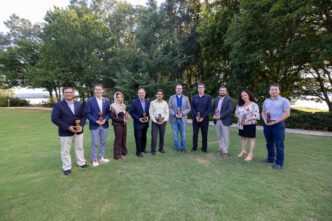CLEMSON — Students and technologists across the country will soon have a new and interactive way to learn about manufacturing the light-based technologies that are crucial for a host of next-generation products and services, including high-speed wireless networks.
The experience will be designed to teach students about photonics manufacturing but not in the traditional book-and-lecture format. Students will learn in online “modules” that incorporate virtual reality, augmented reality, videos and programs that teach but in some cases feel like video games.

Researchers expect their approach to make complex topics in photonics manufacturing more accessible to a wider range of students than if they had to learn solely by sitting in classrooms.
The team developing the curriculum includes researchers from the Massachusetts Institute of Technology, Clemson University and the University of Arizona.
Photonics manufacturers make optical fiber and a wide range of devices that most consumers hardly notice but are critical to modern technology, including the internet, lasers and CT scans.
It’s a large and growing global industry, with a domestic cluster of companies already making considerable amounts of optical fiber in Georgia, North Carolina, and the Northeast, said John Ballato, the Sirrine Endowed Chair of Optical Fiber at Clemson.
Optical fiber will be in even higher demand as 5G wireless networks are installed and begin carrying vast amounts of data that enable new technologies, such as car-to-car communication, he said.
“You’ve got to put even more fiber up the poles, down the roads and into buildings,” Ballato said. “Some of these companies are setting up entirely new fiber-fabrication facilities just for the coming 5G expansion.”
A special focus of the project is integrated photonics.
Integrated photonics, a technology that uses circuits powered by light, is rapidly emerging within the advanced manufacturing scene. This integration of light and electronics can be used to do such things as send signals from computer chips directly into optical fibers at ultra-high speeds.
AIM Photonics, one of 14 Manufacturing USA institutes, is leading the charge to develop advanced manufacturing capabilities in this new area, specializing in fabrication, testing and packaging. Lionel C. Kimerling, the Thomas Lord Professor of Materials Science and Engineering at MIT, is helping support the education and workforce development activities of AIM Photonics, and these educational modules will be used for training employees to meet workforce demands in integrated photonics.
[vid origin=”youtube” vid_id=”fJCVU_EWymI” size=”medium” align=”left”]
About 40 educational modules will be rolled out over the next three years and researchers plan to package them as the Virtual Manufacturing Lab. Some will target technical colleges, while others will be geared for undergraduates and graduate students at universities and four-year colleges.
The modules will be offered through Clemson’s EducateWorkforce.com.
The new modules are aimed at doing for photonics manufacturing what researchers from the Clemson University Center for Workforce Development have done for other forms of advanced manufacturing.
Modules they have created have been used in 22 states, including South Carolina. In one module, students navigate an automotive factory from a first-person viewpoint similar to a video game, but they search for safety violations instead of zapping space aliens.
The researchers leading Clemson’s share of the photonics manufacturing project are Ballato and Kapil Chalil Madathil, the director of technology operations for the Clemson University Center for Workforce Development.
Ballato will tap his vast global contacts, built over 30 years developing advanced optical fibers, to learn more about the workforce needs of large and small businesses that make and use optical fibers.
“We can then develop the relevant curricula,” he said. “As the nation’s premiere optical fiber research and education program, Clemson is well positioned to partner on this project. Clemson is one of only a handful of universities in the world with the level of expertise we bring to the table.”
Chalil Madathil will take the information he learns from Ballato and other subject matter experts, including several at MIT, and then work with a team to create the modules. He said that virtual and augmented reality have the potential to transform multiple fields of study, including photonics manufacturing.
“In this project, we’ll be working with an interdisciplinary team of photonics engineers, scientists and workforce development specialists to design the next generation of learning systems and environments,” Chalil Madathil said. “I’m excited about the modules we will deliver, which could have a profound impact on the photonics workforce and building the next generation of technicians, engineers and scientists.”
Kimerling is serving as principal investigator on the project, which is funded by the Office of Naval Research.
His education research group is working with MIT’s Office of Open Learning to develop integrated photonics courses with virtual-reality circuit simulations for edX.com. At the same time, the Clemson University Center for Workforce Development is developing manufacturing-floor virtual reality simulations with the Advanced Robotics for Manufacturing Institute.
“MIT and Clemson University are uniquely positioned to create a disruptive modular learning format that exploits the ‘learning through play’ methodology of game-based learning to facilitate advanced manufacturing instruction and establish an online means for rapid, autonomous continuing education,” Kimerling said.
Mark Johnson, director of the Clemson University Center for Advanced Manufacturing, said the modules will help support the workforce needs of photonics manufacturers nationwide.
“This program is an innovative way to equip the workforce of tomorrow with the skills needed to succeed,” said Johnson, who is also the Thomas F. Hash Endowed Chair in Sustainable Development. “Our unique confluence of expertise and infrastructure will allow us to help provide industry with a deep, diverse pool of workers who are ready for jobs in photonics manufacturing.”
Anand Gramopadhye, dean of Clemson’s College of Engineering, Computing and Applied Sciences, said the Virtual Manufacturing Lab will help address a nationwide demand for online manufacturing education that uses virtual reality and other cutting-edge technologies to reach as many students as possible.
“Our collaboration with MIT positions us to strategically close the knowledge gap in photonics manufacturing,” said Gramopadhye, who is also Clemson’s principal investigator on the grant. “Through the Virtual Manufacturing Lab, we are widening the pipeline from academia to an industry that is crucial to maintaining national competitiveness.”








